Outlook 2016 Logs .etl How to Read
The tutorial explains how to archive emails in Outlook 2019, Outlook 2016, Outlook 2013, and other versions. Yous volition learn how to configure each folder with its own machine archive settings or apply the aforementioned settings to all folders, how to archive in Outlook manually, and how to create annal folder if information technology doesn't appear automatically.
If your mailbox has grown too large in size, information technology stands to reason to annal old emails, tasks, notes and other items to keep your Outlook fast and clean. That's where the Outlook Annal feature comes in. Information technology is bachelor in all versions of Outlook 365, Outlook 2019, Outlook 2016, Outlook 2013, Outlook 2010 and before. And this tutorial volition teach y'all how to archive emails and other items in different versions automatically or manually.
What is archive in Outlook?
Outlook Archive (and AutoArchive) moves older electronic mail, task and calendar items to an annal binder, which is stored in some other location on your hard drive. Technically, archiving transfers older items from the main .pst file into a separate archive.pst file that you can open from Outlook whatever time you demand information technology. This way, it helps yous reduce the size of your mailbox and become some free space back on your C:\ drive (if you choose to store the archive file somewhere else).
Depending on how you configure information technology, Outlook Archive can perform one of the following tasks:
- Motion emails and other items from their current folders to an archive folder.
- Permanently delete onetime emails and other items equally before long as they accept passed the specified aging period.
v facts you should know virtually Outlook Archive
To avoid confusion and to prevent questions similar "Why doesn't my Outlook Car Archive piece of work?" and "Where are my archived emails in Outlook?" please remember the following simple facts.
- For near account types, Microsoft Outlook keeps all emails, contacts, appointments, tasks and notes in a .pst file called the Outlook Information File. PST is the only file type that tin be archived. As soon equally an old item is moved from the chief .pst file into an annal.pst file, it is displayed in the Outlook Archive folder, and is no longer bachelor in the original folder.
- Archiving is not the aforementioned as exporting. Exporting copies the original items to the consign file, but does not remove them from the current binder, nor from the primary .pst file.
- An archive file is non the same as Outlook backup. If you want to back up your archived items, you will accept to brand a copy of your annal.pst file and store information technology in a rubber location, eastward.m. Dropbox or One Bulldoze.
- Contacts are never auto-archived in any Outlook version. Still, you can annal the Contacts folder manually.
- If you accept an Outlook Commutation account with an online archive mailbox, archiving in Outlook is disabled.
How to archive emails in Outlook automatically
The Outlook Auto Annal feature can be configured to motion old emails and other items to a designated annal binder automatically at a regular interval, or to delete old items without archiving. The detailed steps for different Outlook versions follow below.
How to auto archive Outlook 2019 - 2010
Since Outlook 2010, Auto Archive is not enabled past default, though Microsoft Outlook will periodically remind you to practise so:

To start archiving immediately, click Yep. To review and probably modify the archive options, click AutoArchive Settings….
Or, you lot can click No to close the prompt, and configure auto archiving after at the time most user-friendly to yous by performing the following steps.
- Open Outlook, and then click File >Options >Advanced >AutoArchive Settings…
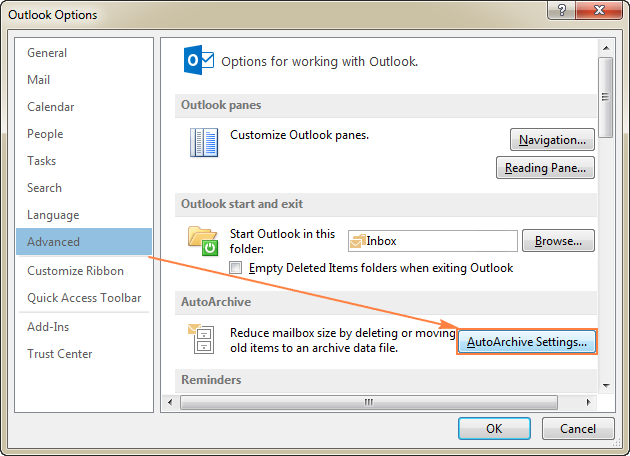
- The AutoArchive dialog window opens, and you will detect that everything is grayed out… only only until you check the Run AutoArchive every N days Once this box is checked, you can configure other options to your liking, and click OK.
The screenshot below shows the default settings, and the detailed info about each selection can exist found hither.

When archiving is in progress, the status data is displayed in the status bar.
![]()
Equally soon as the archive procedure is completed, the Archives binder will appear in your Outlook automatically, provided you selected the pick Prove archive folder in the folder listing. If you cannot discover archived emails in your Outlook, please see How to brandish Outlook archive folder.
How to motorcar annal Outlook 2007
In Outlook 2007, motorcar archiving is turned on by default for the following folders:
- Calendar, task and periodical items (older than 6 months)
- Sent Items and Deleted Items folders (older than 2 months)
For other folders, such as Inbox, Drafts, Notes and others, you can turn on the AutoArchive feature in this way:
- Open up Outlook and click Tools >Options.
- In the Options dialog window, go to the Other tab, and click the AutoArchive… button.
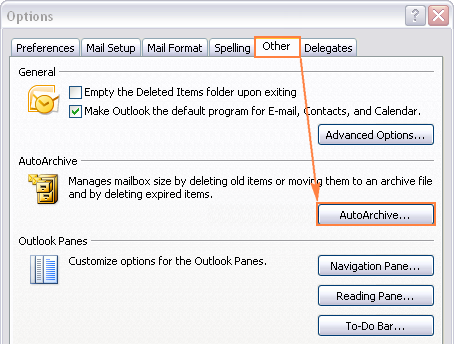
And then, configure the AutoArchive settings as explained below.
Outlook Auto Archive settings and options
Equally yous already know, in Outlook 2010 and later, Auto Archive settings tin can exist accessed via File >Options >Advanced >AutoArchive Settings… The detailed information about each option volition aid you take the process under your total control.
- Run AutoArchive every Northward days. Specify how frequently you want AutoArchive to run. Please go along in mind that archiving many items at a time may slow your computer'southward operation. And so if y'all receive lots of emails on a daily basis, configure your Outlook Automobile Annal to run more than often. To turn off car-archiving, articulate this box.
- Prompt before AutoArchive runs. Check this box if you want to get a reminder immediately before the auto-annal process starts. This will permit you abolish auto archiving by clicking No in the prompt.
- Delete expired items (e-mail folders only). Selecting this selection will delete expired messages from your email folders. For the sake of clarity, an expired email is not the same equally an old bulletin that has reached the end of its aging period. An expiration date is set for each message individually via the Options tab of the new e-mail window (Options >Tracking group > Expires after).
Microsoft states that this option is not checked by default, just it was checked on some of my Outlook installations. Then exist sure to uncheck this option if y'all want to go on expired messages until they reach the finish of the aging catamenia set for a given folder.
- Archive or delete old items. Select this choice if yous desire to configure your own auto-archive settings. If unchecked, Outlook will use the default AutoArchive settings.
- Show archive folder in folder list. If you want the Archive binder to announced in the Navigation Pane forth with your other folders, select this box. If unselected, yous will still be able to open your Outlook archive folder manually.
- Clean out items older than. Specify the aging period after which your Outlook items should be archived. You can configure the period in days, weeks, or months - a minimum of 1 day up to a maximum of 60 months.
- Movement old items to. When this choice is selected, Outlook automatically moves old emails and other items to the archive.pst file instead of deleting them (selecting this radio button clears the pick of Permanently delete items). By default, Outlook stores the archive.pst file in 1 of these locations. To choose some other location or give another name to the archived .pst, click the Browse button.
- Permanently delete items. This volition delete old items permanently every bit soon as they reach the cease of the aging period, no archive copy will be created.
- Apply these settings to all folders now. To apply the configured AutoArchive settings to all folders, click this button. If you want to employ other settings for 1 or more folders, practise not click this push button. Instead, configure the archiving settings for each binder manually.
Default aging periods used past Outlook Auto Archive
The default aging periods in all Outlook versions are as follows:
- Inbox, Drafts, Agenda, Tasks, Notes, Journal - half-dozen months
- Outbox - 3 months
- Sent Items, Deleted Items - 2 months
- Contacts - are not auto archived
The default periods can be changed for each folder individually using the Mailbox Cleanup option.
Outlook determines the age of a item item based on the following information:
- Emails - the received appointment or the date when you last changed and saved the message (edited, exported, copied, and and so on).
- Agenda items (meetings, events, and appointments) - the engagement when you last inverse and saved the detail. Recurring items are not auto archived.
- Tasks - the completion engagement or the last modification date, whichever is after. Open tasks (tasks that are not marked consummate) are not car archived.
- Notes and journal entries - the engagement when an detail was created or last modified.
If you desire to archive items by received / completed engagement, delight employ these guidelines: How to archive emails by received date.
How to exclude a specific binder from Automobile Archive or apply different settings
To forestall Outlook Auto Archive from running on a certain folder, or set a different schedule and options for that folder, perform the following steps.
- Right click on the folder, and and so click Properties… in the context carte.
- In the Properties dialog window, do one of the following:
- To exclude the binder from machine archiving, select the Practise not archive items in this folder radio box.

- To annal the folder differently, select Archive this binder using these settings, and set up the desired options:
- aging period later on which items should be moved to archive;
- whether to use the default archive binder or a different folder, or
- permanently delete old items without archiving.
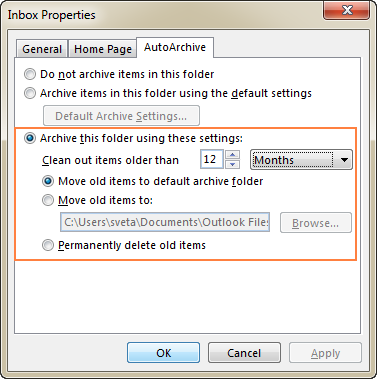
- Click OK to save the changes.
- To exclude the binder from machine archiving, select the Practise not archive items in this folder radio box.
Tip. You can use this method to automatically delete old emails from the Deleted Items and Junk E-mail folders. The detailed steps are hither.
How to create archive folder in Outlook
If you selected the Show archive folder in folder list selection when configuring the Outlook Auto Archive settings, the Archives binder should announced in the Navigation pane automatically. If the higher up option was non selected, you can display the Outlook Archive folder in this way:
- Click File >Open up & Export > Open Outlook Data File.

- The Open up Outlook Data File dialog box will open up, you select the archive.pst file (or any name y'all gave to your annal file) and click OK. If you lot chose to shop your Outlook archive in a different location, navigate to that location and select your archived .pst file.
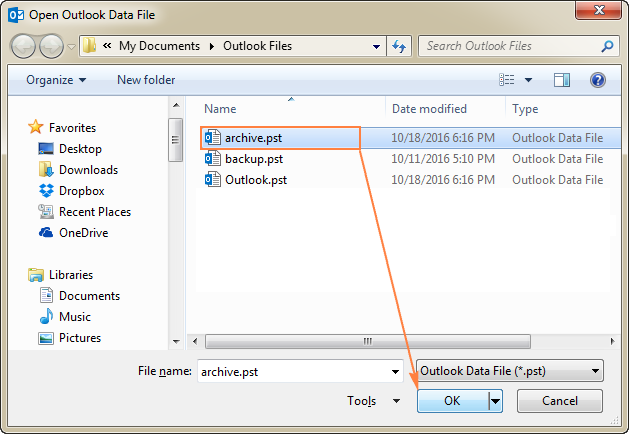
That's it! The Archive folder volition show upwards in the listing of folders direct abroad:

Once the Archive folder is there, you can detect and open your archived items as usual. To search in Outlook archive, select the Annal binder in the Navigation Pane, and type your search text in the Instant Search box.
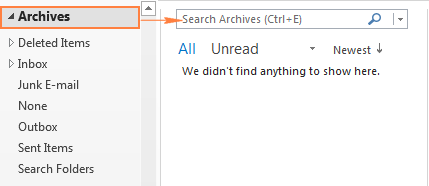
To remove the Annal folder from your listing of folders, right click on it, and then click Close Archive. Don't worry, this will simply remove the Archives folder from the Navigation pane, but won't delete the actual archive file. You volition be able to restore your Outlook Annal folder whatsoever time you need it by performing the above steps.
How to turn off car archiving in Outlook
To turn off the AutoArchive feature, open up the AutoArchive Settings dialog, and uncheck the Run AutoArchive every Due north days box.
How to annal in Outlook manually (email, calendar, tasks and other folders)
If you lot don't want any automated archiving, you can archive emails and other items manually whenever you want. This way, you can take more control over which items to continue and which to move to the archive, where to store the archive file, and and so on.
Delight keep in mind that unlike Outlook AutoArchive, manual archiving is a one-time process, and you will need to echo the below steps each time you want to move older items to archive.
- In Outlook 2016, go to the File tab, and click Tools >Clean up old items.
In Outlook 2010 and Outlook 2013, click File >Cleanup Tool >Archive…
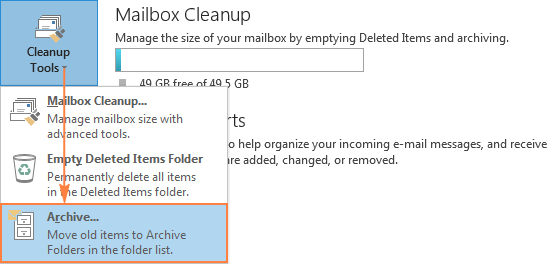
- In the Archive dialog box, select the Annal this folder and all subfolders option, and and so select a folder to archive. For example, to annal Outlook calendar, select the Agenda folder:
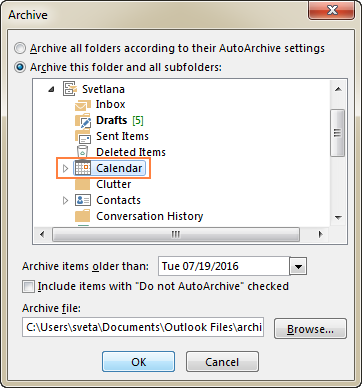
If you want to archive all emails, calendars, and tasks, select the root folder in your Outlook mailbox, i.e. the ane at the top of your folder listing. By default, in Outlook 2010 and later versions, the root folder is displayed as your email address (I've renamed mine to Svetlana every bit shown in the screenshot below):

So, configure a few more than settings:
- Under Archive items older than, enter a date specifying how erstwhile an item has to exist earlier it can be move to the archive.
- Click the Scan push button if you lot want to change the default location of the archive file.
- If you want to annal items that are excluded from auto-archiving, select the Include items with "Do non AutoArchive" checked box.
Finally, click OK, and Outlook will begin creating an archive immediately. Every bit shortly equally the process is completed, the Archive folder will appear in your Outlook.
Tips and notes:
- To annal a few folders using different settings, e.k. go along items in your Sent Items folder longer than in Drafts, echo the in a higher place steps for each folder individually, and salve all folders to the same archive.pst file. If you cull to create a few different annal files, each file will add together its ain Archives folder to your list of folders.
- The Outlook Archive maintains the existing folder structure. For example, if y'all cull to archive only one binder, and that folder has a parent folder, an empty parent folder will be created in the archive.
Where are Outlook Archive files stored?
As you already know, Outlook archive is a type of Outlook Data File (.pst) file. The archive.pst file is automatically created the commencement time car archive runs or when y'all archive emails manually.
The annal file location depends on the operating system installed on your computer. Unless yous inverse the default location when configuring the annal settings, you can find the archive file in 1 of the following places:
Outlook 2019 - 2010
- Vista, Windows 7, viii, and 10 C:\Users\<user name>\Documents\Outlook Files\archive.pst
- Windows XP C:\Documents and Settings\<user name>\Local Settings\Awarding Data\Microsoft\Outlook\archive.pst
Outlook 2007 and before
- Vista and Windows 7 C:\Users\<user name>\AppData\Local\Microsoft\Outlook\archive.pst
- Windows XP C:\Documents and Settings\<user name>\Local Settings\Application Data\Microsoft\Outlook\annal.pst
Notation. Awarding Data and AppData are hidden folders. To display them, go to Control Panel >Folder Options, switch to the View tab, and select Show hidden files, folders, or drives under Hidden files and folders.
How to discover the annal file location on your machine
If you cannot find the archive .pst file in any of the to a higher place locations, chances are that you chose to store it in a different identify when configuring the automobile archive settings.
Here's a quick fashion to determine the exact location of your Outlook archive: right-click the Annal folder in the list of folders, and then click Open File Location. This will immediately open the folder where your archived .pst file is stored.
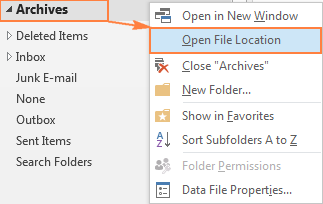
If y'all have created a few different archive files, you lot can view all the locations at a glance in this way:
- Click File >Account Settings >Business relationship Settings.
- In the Account Settings dialog, switch to the Information Files tab.
- Amidst other files, you will come across the current location of the archive.pst file (or whatever proper noun you gave to your archive file).
- To get to the folder where a certain annal file is stored, select the desired file, and click Open File Location.
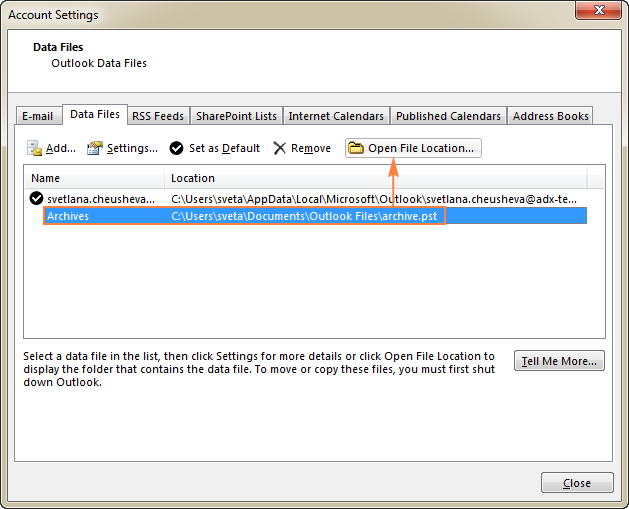
Outlook Annal tips and tricks
In the start part of this tutorial, we have covered the Outlook Archive essentials. And now, it's time to learn a few techniques that go beyond the nuts.
How to modify the existing location of your Outlook archive
If for some reason y'all need to relocate your existing Outlook archive, merely moving the archived .pst file to a new folder will outcome in a new archive.pst file being created in the default location the next time your Outlook AutoArchive runs.
To move the Outlook annal properly, perform the following steps.
1. Close Annal in Outlook
To disconnect the Outlook Archive folder, right click on the root Archive binder in the listing of folders, and click Close Archive.

Tip. If the Athenaeum folder does not announced in your listing of folders, yous tin can find its location via File >Business relationship Settings >Account Settings >Data Files tab, select the archived .pst file, and click the Remove button. This will but disconnect the archive from your Outlook, only won't delete the archived .pst file.
ii. Motion the archive file to where you want it.
Close Outlook, browse to the location of your archived .pst file, and copy information technology to the folder of your choosing. Once your Outlook archive is copied, you can delete the original file. Though, a safer style would be rename it to archive-erstwhile.pst and go on until you lot've made sure that the copied file is working.
three. Reconnect the moved archive.pst file
To reconnect the archive file, open Outlook, click File >Open >Outlook Data File…, browse to the new location of your archive file, select the file and click OK to connect it. The Archives folder volition immediately evidence up in your list of folders.
four. Alter your Outlook Auto Archive settings
The final only not the least step is modifying the AutoArchive settings and so that from now on Outlook will move quondam items to the new location of your archived .pst file. Otherwise, Outlook will create another annal.pst file in the original location.
To do this, click File >Options >Advanced >AutoArchive Settings…, make sure the Motion old items to radio button is selected, click the Browse button and betoken it to where you moved your Outlook archive file.
How to empty Deleted Items and Junk Email folders automatically
To have delete one-time items from the Deleted Items and Junk Eastward-mail folders automatically, set Outlook AutoArchive to run every few days, and then configure the following settings for the in a higher place folders:
- Right click the Deleted Items folder, and click Backdrop >AutoArchive.
- Select the Archive this folder using these settings option, and pick the desired number of days next to Make clean out items older than.
- Choose to Permanently delete old items, and click OK.
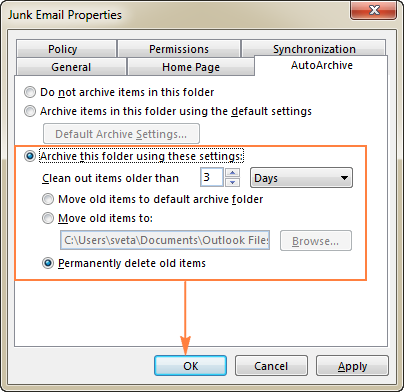
Repeat the above steps for the Junk E-mails binder, and you are all set!
Note. Older items volition exist deleted from the Junk and Deleted items folders on the adjacent AutoArchive run. For case, if you lot configured AutoArchive to run every 14 days, the folders will be cleaned out every two weeks. If you want to delete junk emails more often, set a smaller period for your Outlook Machine Archive.
How to archive emails past received engagement
The default settings of Outlook AutoArchive decide an particular's age based on the received/competed or modified date, whichever is later. In other words, if after receiving an email message or mark a chore consummate, you make any changes to an detail (due east.chiliad. import, consign, edit, copy, mark as read or unread), the modified date is inverse, and the detail won't be move to the archive folder until another aging period is over.
If you want Outlook to disregard the modified date, y'all tin can configure it to archive items by the post-obit dates:
- Emails - the received date
- Agenda items - the date that an appointment, effect or meeting is scheduled for
- Tasks - the completion engagement
- Notes - the date of the last modification
- Journal entries - the engagement of creation
Note. The solution requires making changes to the registry, then we recommend using information technology very carefully considering serious issues may occur if you alter the registry incorrectly. As an extra precaution, exist sure to support the registry earlier modifying information technology. If you work in a corporate environment, you'd better have your admin do this for you, to exist on the safe side.
For starters, bank check your Outlook version. If y'all are using Outlook 2010, be sure to install April 2011 hotfix for Outlook 2010, and Outlook 2007 users demand to install the December 2010 hotfix for Outlook 2007. Outlook 2013 and Outlook 2016 do not require any additional updates.
And now, follow the below steps to create the ArchiveIgnoreLastModifiedTime registry value:
- To open the registry, click Start >Run, blazon regedit in the search box, and click OK.
- Notice and select the following registry primal:
HKEY_CURRENT_USER\Software\Microsoft\Office\<Office version>\Outlook\PreferencesFor example, in Outlook 2013, it is:
HKEY_CURRENT_USER\Software\Microsoft\Role\15.0\Outlook\Preferences
- On the Edit carte, signal to New, select DWORD (32 fleck) Value, type its proper noun ArchiveIgnoreLastModifiedTime, and press Enter. The result should expect similar to this:

- Right-click the newly created ArchiveIgnoreLastModifiedTime value, click Modify, blazon 1 in the Value data box, and so OK.
- Close the Registry Editor, and restart your Outlook for the changes to have consequence. Done!
Outlook Annal not working - reasons and solutions
If Outlook Archive or AutoArchive does non work as expected or you have issues with finding your archived emails in Outlook, the post-obit troubleshooting tips can help you lot determine the source of the problem.
1. Archive and AutoArchive options are not available in Outlook
Virtually probable, yous are using the Exchange Server mailbox, or your organization has a post retention policy that overrides Outlook AutoArchive, e.chiliad. it was disabled by your administrator as a Group Policy. If it is the instance, please check the details with your organisation administrator.
2. AutoArchive is configured, but doesn't runs
If suddenly Outlook Auto Archive has stopped working, open the AutoArchive settings, and make certain the Run AutoArchive every N days checkbox is selected.
3. A specific item is never archived
In that location are 2 frequent reasons for a certain item to exist excluded from car archive:
- The detail'due south modified date is newer than the appointment set up for archiving. For a solution, please see How to archive items by received or completed date.
- The Do not AutoArchive this item holding is selected for a given item. To check this, open the item in a new window, click File >Properties, and remove a tick from this checkbox:

You can likewise add the Practice Not AutoArchive field to your Outlook view to become an overview of items for which this option is selected.
4. Archive folder is missing in Outlook
If the Archives folder does not announced in the listing of folders, open the AutoArchive settings, and verify that the Show annal folder in binder listing option is selected. If the Annal folder still does non prove upwardly, open the Outlook Information File manually, as explained here.
v. Damaged or corrupted annal.pst file
When the annal.pst file is damaged, Outlook is not able to move whatsoever new items into it. In this case, shut Outlook and employ the Inbox Repair Tool (scanpst.exe) to repair your archived .pst file. If it does not work, the merely solution is to create a new archive.
6. Outlook mailbox or annal file reached the maximum size
A full annal.pst or main .pst file can besides prevent Outlook Archive from working.
If the annal.pst file has reached its limit, clean it up by deleting old items or create a new archive file.
If the main .pst file has reached its limit, try deleting some old items manually, or empty the Deleted Items folder, or move some items to your archive past mitt, or have your administrator to temporarily increment the size of your mailbox, so run AutoArchive or archive old items manually.
The default limit for .pst files is 20GB in Outlook 2007, and 50GB in later versions.
I promise this tutorial has shed some light on how to annal emails in Outlook. Anyway, I give thanks yous for reading and hope to see yous on our blog next calendar week!
You may also be interested in
Source: https://www.ablebits.com/office-addins-blog/2016/11/09/outlook-archive-emails/
0 Response to "Outlook 2016 Logs .etl How to Read"
إرسال تعليق